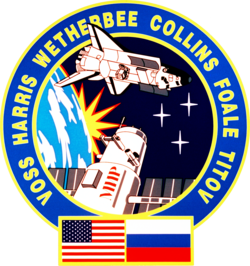Jim Wetherbee
| James Wetherbee | |
|---|---|
 | |
| Land: | USA |
| Organisation: | NASA |
| ausgewählt am | 23. Mai 1984 (10. NASA-Gruppe) |
| Einsätze: | 6 Raumflüge |
| Start des ersten Raumflugs: | 9. Januar 1990 |
| Landung des letzten Raumflugs: | 7. Dezember 2002 |
| Zeit im Weltraum: | 66d 10h 23m |
| ausgeschieden am | Januar 2005 |
| Raumflüge | |
James Donald Wetherbee (* 27. November 1952 in Flushing, Queens, New York City, USA) ist ein ehemaliger amerikanischer Astronaut.
Wetherbee wurde in Flushing geboren, aufgewachsen ist er jedoch 60 Kilometer entfernt, in der Kleinstadt Huntington Station, wo seine Eltern heute noch leben. Nach einer katholischen High School besuchte er die katholische University of Notre Dame in Indiana. Dort studierte er Luft- und Raumfahrttechnik und erhielt 1974 einen Bachelor. (US-Außenministerin Condoleezza Rice war zur gleichen Zeit an der Notre-Dame-Uni eingeschrieben).
Gleich nach seinem Abschluss trat Wetherbee in die US Navy ein und machte dort Karriere als Marineflieger. Nach seiner Ausbildung zum Piloten diente er drei Jahre auf dem Flugzeugträger „USS John F. Kennedy“ bis man ihn ab 1980 an der United States Naval Test Pilot School in Patuxent River (Maryland) zum Testpiloten ausbildete. Anschließend war er in verschiedenen leitenden Positionen mit der Weiterentwicklung des Kampfflugzeugs F/A-18 „Hornet“ befasst. Anfang 1984 kam er zum 132. Kampfgeschwader auf die Naval Air Station Lemoore in Kalifornien, wo er bis zu seiner Einstellung als Astronaut tätig war.
Astronautentätigkeit
Wetherbee kam im Mai 1984 als Astronautenkandidat zur NASA. Er hatte schon immer diesen Beruf ergreifen wollen, war sich aber bewusst, dass die Wahrscheinlichkeit sehr klein sein würde. Obwohl er sich in der Marine sehr wohlfühlte, hatte er seinen Wunsch, Astronaut zu werden, stets im Hinterkopf. Es war seine Frau, die ihn bestärkte, sich bei der NASA zu bewerben. Er war Testpilot, als er schließlich seine Unterlagen einreichte und gleich bei seinem ersten Versuch angenommen wurde.
Nach Beendigung der Grundausbildung im Juni 1985 bis zur Challenger-Katastrophe im Januar 1986 war er als CapCom im Missionskontrollzentrum tätig.
Seine erste Ernennung für eine Space-Shuttle-Mission erfolgte im November 1988 als Pilot von STS-32. Ziel des Fluges vom Januar 1990 war neben dem Aussetzen eines Kommunikationssatelliten der Intelsat-Serie das Einfangen der Forschungsplattform LDEF, die fast sechs Jahre im All verbrachte.
Zunächst als Pilot für STS-46 ernannt, übertrug man Wetherbee im Herbst 1991 sein erstes eigenes Kommando: STS-52 im Oktober 1992 mit der Raumfähre Columbia setzte den italienisch-amerikanischen Trabanten LAGEOS-2 aus. Ebenfalls wurden an Bord im Rahmen der „United States Microgravity Payload (USMP-1)“ drei Mikrogravitationsexperimente aus den USA und Frankreich durchgeführt.
Nur ein Jahr nach STS-52 wurde Wetherbee für seine dritte Mission aufgestellt. STS-63 schrieb Anfang Februar 1995 Raumfahrtgeschichte, als die Besatzung um Kommandant Wetherbee im Laufe des Fluges das erste Rendezvous einer US-Raumfähre (mit Pilotin Eileen Collins erstmals von einer Frau gesteuert) mit der russischen Station Mir durchführte.
Im Herbst 1997 leitete Wetherbee die Mission STS-86. Es war der neunte Flug im Rahmen des Shuttle-Mir-Programms, der die siebente Kopplung eines Shuttles an die Mir-Station zum Ziel hatte. Die Fähre Atlantis brachte Versorgungsgüter und die Ablösung für Michael Foale zur Raumstation. Astronaut Foale hatte seit Mai an Bord gearbeitet und wurde nun durch David Wolf abgelöst.
Bis zu seinem nächsten Raumflug arbeitete Wetherbee in der Verwaltung: seit dem Herbst 1995 war er fünf Jahre lang stellvertretender Direktor des Johnson Space Center (JSC).
Wetherbees fünfter Flug fand im März 2001 als Kommandant von STS-102 statt. Die Discovery brachte Ausrüstungsteile und eine frische Mannschaft zur im Bau befindlichen Internationalen Raumstation (ISS). Dazu befand sich im Frachtraum des Orbiters das Leonardo-Modul, in dem sich der Hauptteil der auszuliefernden Nutzlasten befand. Die Shuttle-Crew brachte die 2. Stammbesatzung zur ISS und holte die 1. Mannschaft nach 140 Tagen Dienst wieder ab.
Als Wetherbee Ende 2002 mit STS-113 zu seinem letzten Raumflug startete, war er der erste Astronaut, der fünf Missionen geleitet hatte. Die Endeavour brachte den P1-Träger zur ISS. Bei drei Ausstiegen wurde die 12-Tonnen-Struktur an die Raumstation angebaut. Außerdem löste die 6. ISS-Besatzung die ISS-Expedition 5 ab.
Jim Wetherbee trat 2003 aus der US-Marine aus und verließ Anfang 2005 die NASA. Er und seine Frau Robin haben zwei Töchter.
Siehe auch
Weblinks
- Biografie von Jim Wetherbee in der Encyclopedia Astronautica (englisch)
- Kurzbiografie von Jim Wetherbee bei spacefacts.de
- NASA-Biografie von Jim Wetherbee (englisch; PDF)
| Personendaten | |
|---|---|
| NAME | Wetherbee, Jim |
| ALTERNATIVNAMEN | Wetherbee, James Donald (vollständiger Name) |
| KURZBESCHREIBUNG | US-amerikanischer Astronaut |
| GEBURTSDATUM | 27. November 1952 |
| GEBURTSORT | New York City, USA |
Auf dieser Seite verwendete Medien
* This is the crew patch for the STS-113 mission, which will be the eleventh American (11A) assembly flight to the International Space Station (ISS). The primary mission will be to take the Expedition Six crew to the ISS and return the Expedition Five crew to Earth. STS-113 will be the first flight in the assembly sequence to install a major component in addition to performing a crew exchange. The Port 1 Integrated Truss Assembly (P1) will be the first truss segment on the left side of the ISS. P1 will provide an additional three External Thermal Control System radiators, adding to the three radiators on the Starboard 1 (S1) Integrated Truss Assembly. The installation and outfitting of P1 will require three extravehicular activities (space walks) as well as coordination between the Shuttle Robotic Manipulator System and the Space Station Robotic Manipulator System. The patch depicts the Space Shuttle Endeavour docked to the ISS during the installation of the P1 truss with the gold astronaut symbol in the background.
- The seven stars at the top left center of the patch are the seven brightest stars in the constellation Orion. They represent the combined seven crew members (four Shuttle and three Expedition Six). The three stars to the right of the astronaut symbol represent the returning Expedition Five crew members. The Shuttle crew names are on the solar arrays of the P6 truss. The ISS Expedition crew names are in a chevron that also features the American and Russian flags. The Expedition 6 crew names are on top of the Expedition 5 crew names, since Expedition 6 goes up while Expedition 5 goes down. The Roman Numeral CXIII represents the mission number 113.
STS-32 Mission Insignia
- The STS-32 patch, designed by the five crewmembers for the January, 1990 space mission, depicts the Space Shuttle orbiter rendezvousing with the Long Duration Exposure Facility (LDEF) satellite from above and the Syncom satellite successfully deployed and on its way to geosynchronous orbit. Five stars represent the mission number with three on one side of the orbiter and two on the other. The seven major rays of the sun are in remembrance of the crewmembers for STS 51-L. In preparation for the first Extended Duration Orbiter (EDO) missions, STS-32 conducted a number of medical and middeck scientific experiments. The caduceus on the left represents the medical experiments, and the crystalline structure on the right represents the materials science. The crew is comprised of Astronauts Daniel C. Brandenstein, James D. Wetherbee, Bonnie Dunbar, Marsha S. Ivins, and G. David Low.
STS-52 Columbia, Orbiter Vehicle (OV) 102, crew insignia (logo), the Official insignia of the NASA STS-52 mission, features a large gold star to symbolize the crew's mission on the frontiers of space. A gold star is often used to symbolize the frontier period of the American West. The red star in the shape of the Greek letter lambda represents both the laser measurements to be taken from the Laser Geodynamic Satellite (LAGEOS II) and the Lambda Point Experiment, which is part of the United States Microgravity Payload (USMP-1). The LAGEOS II is a joint Italian \ United States (U.S.) satellite project intended to further our understanding of global plate tectonics. The USMP-1 is a microgravity facility which has French and U.S. experiments designed to test the theory of cooperative phase transitions and to study the solid\liquid interface of a metallic alloy in the low gravity environment. The remote manipulator system (RMS) arm and maple leaf are emblematic of the Canadian payload specialist Steven MacLean.
The STS-86 flight was the seventh shuttle-Mir docking mission, symbolized by seven stars. The international crew includes astronauts from the United States, Russia, and France. The flags of these nations are incorporated in the rays of the astronaut logo. The rays of light streaking across the sky depict the orbital tracks of the two spacecraft as they prepare to dock. During the flight, an American astronaut and a Russian cosmonaut will perform an extravehicular activity (EVA). The mercator projection of Earth illustrates the global cooperative nature of the flight.
STS-63 Mission Insignia
The STS-102 crew insignia depicts the International Space Station as it looked when Space Shuttle Discovery was docked. Visible elements include the P6 and Z1 trusses, solar arrays from the Russian segment, 2 Pressurized Mating Adapters, and the Multi Purpose Logistics Module that was temporarily attached to the underside of the Unity Node. The numbers "102" represent the mission tail number. The red, white, and blue ribbons surrounding the space station represent that this is a crew rotation flight. The colors represent the nationalities of the crewmembers (Russian and American). Underneath the ribbons are the flags of the three nations who are the major contributors to the mission (from left to right: Russia, United States, Italy). The names of the 4 permanent crewmembers are displayed in gold around the top of the emblem. Attached to the bottom are six names depicting the six rotating crewmembers (Expedition 2 on top and Expedition 1 on bottom).
portrait astronaut james d wetherbee






